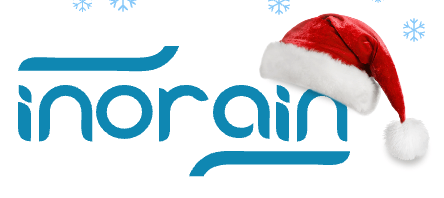
OTT Advertising: Types, Best Practices, and Strategies
Over-the-top (OTT) advertising has transformed how brands connect with consumers. Thanks to OTT ads and video streaming, digital marketers can engage audiences during one of the most critical stages of the buyer’s journey: discovery.
But what is OTT in marketing, specifically? How does OTT advertising work? Which platforms are worth your time?
This in-depth guide has all the answers you need. Let’s explore!
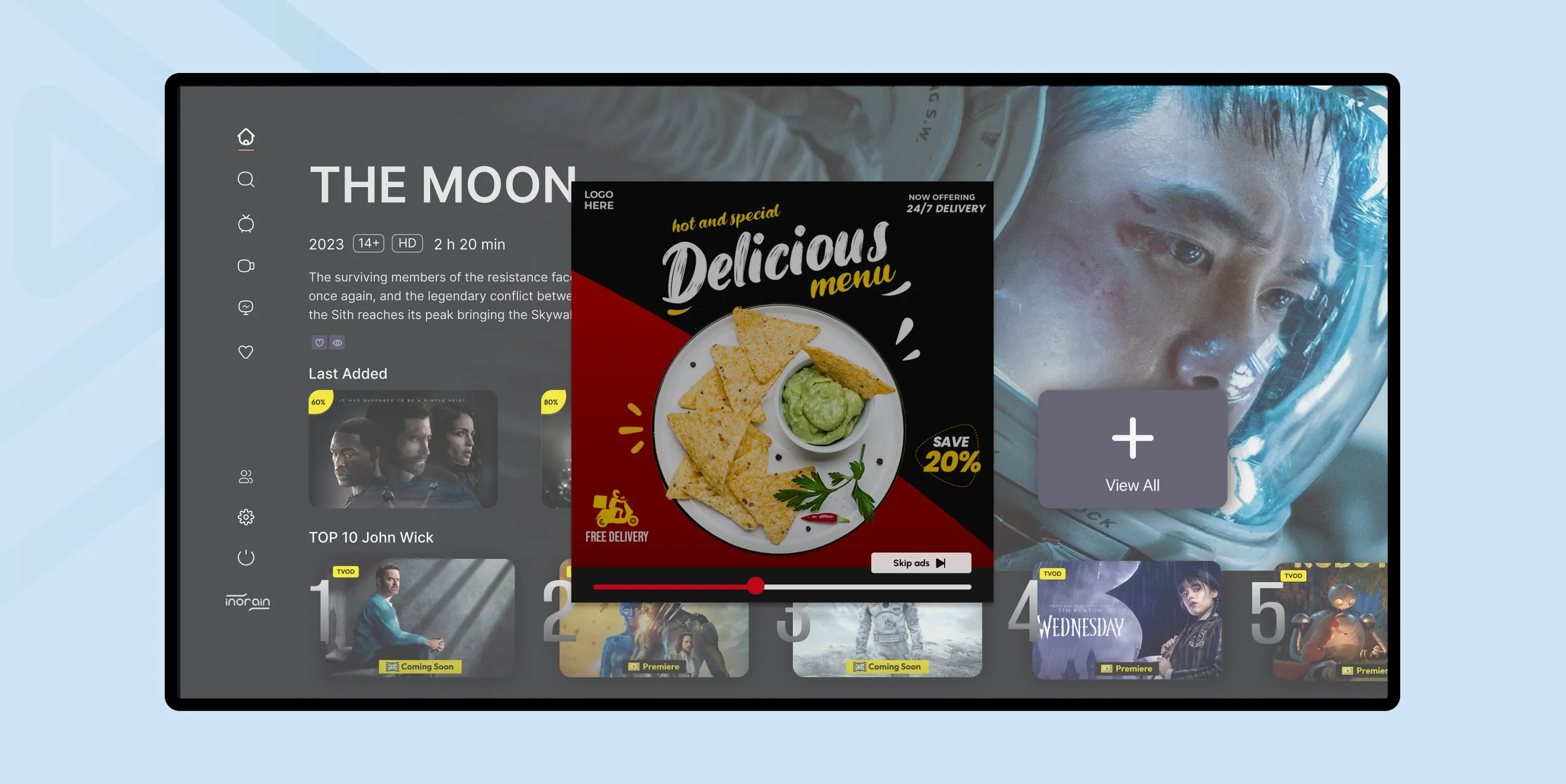
What is OTT Advertising?
OTT advertising is a form of digital marketing in which ads are delivered to viewers via the Internet through streaming video services like Netflix, Hulu, Amazon Prime Video, Disney+, and others.
Unlike traditional TV ads, OTT advertising allows brands like yours to target highly relevant audiences. With AI-powered data analytics and targeting capabilities, advertisers can reach viewers based on various criteria, including location, demographics, interests, and behaviors.
In short, OTT advertising offers you a modern, targeted, and realizable way to reach consumers, making it an effective marketing tool.
OTT Advertising Overview
- Definition: OTT advertising refers to delivering ads through video content provided via streaming services over the internet, bypassing traditional distribution methods like cable.
- Ad Formats: OTT ad formats include pre-roll, mid-roll, and post-roll advertisements.
- Monetization Models: OTT offers revenue generation through different monetization models, including AVOD, SVOD, TVOD, and hybrid.
- Targeting: OTT video ads target audiences according to data like demographics, preferences, and viewing behavior, ensuring that ads reach the proper audience at the right time.
- Cross-Device Reach: OTT advertising is available on all devices, such as computers, tablets, smartphones, and smart TVs.
- Statistics and Analytics: These tools offer precise data on ad performance, viewer engagement, and deals. They help with data-based optimizations for better ROI.
What Are the Benefits of OTT Advertising?
OTT advertising is highly beneficial compared to traditional advertising. There are significant features that you can use to boost your marketing campaigns. Let’s take a look.
Diverse Ad Formats for Maximum Reach
OTT advertising offers various ad placements to capture audience attention effectively:
- Pre-roll ads: Appear before the content starts, ensuring immediate visibility.
- Mid-roll ads: Placed during the content, maintaining high engagement levels.
- Post-roll ads: Shown after the content, targeting highly engaged viewers.
Interactivity and Personalization
Unlike traditional TV commercials, OTT ads are interactive, allowing viewers to:
- Click on links or shop directly from ads.
- Engage with tailored ad content based on their preferences and behavior.
- Experience a more immersive advertising journey, enhancing brand recall.
Cross-Device Compatibility
One of the standout features of OTT advertising is its ability to reach audiences across multiple devices, including:
- Smart TVs for a traditional viewing experience with modern targeting capabilities.
- Mobile Phones and Tablets for on-the-go access and personalized content.
- Laptops and Desktops caterring to viewers consuming content across digital platforms.
Enhanced Viewer Experience Through Targeting
OTT platforms use data-driven strategies to deliver ads relevant to individual users. Key targeting features include:
- Behavioral Targeting: Ads are personalized based on user activity and content preferences.
- Demographic and Geographic Targeting: Ensuring brands reach their desired audience segments efficiently.
- Contextual Targeting: Aligning ad placements with relevant content genres for increased impact.
Advanced Ad Technologies for Optimization
With OTT advertising, you can benefit from technologies, such as:
- AI-Driven Targeting: Machine learning algorithms enhance ad personalization and effectiveness.
- Dynamic Ad Insertion (DAI): Enables real-time ad placements, optimizing ad delivery based on audience engagement.
- Programmatic Buying: Automates ad purchasing, ensuring efficient and cost-effective ad placements.
So, in conclusion, here is what you get with OTT advertising:
Increased Engagement: OTT ads provide higher engagement rates than traditional ones due to targeting and less ad boredom among viewers. A study by Samsung Ads found that OTT ad engagement rates are higher than standard TV ads.
Improved Brand Recognition: Since OTT ads are more interactive, viewers can engage with the content and learn about the brand. This boosts brand interaction and recall.
Expanded Reach: OTT video ads reach cord-cutters (people who cancel a subscription to cable television services) and digital-first audiences.
A study by Magna and IPG Media Lab revealed that cord-cutters aren’t just Millennials and Gen Z viewers, with 40% of non-linear TV or OTT platform viewers being ages 38 to 53 or older with high-income households of $100,000. This highlights the advantages of reaching bigger, diverse, and affluent audiences.
Affordability: OTT video ad campaigns are tailored to advertisers' budgets and marketing goals, offering flexibility in managing campaigns and the ability to reach broad audiences.
8 Types of OTT Advertising
One advertising type can’t be suitable for every product and marketing campaign. So, OTT offers a variety of advertising types you can use for your business goals.
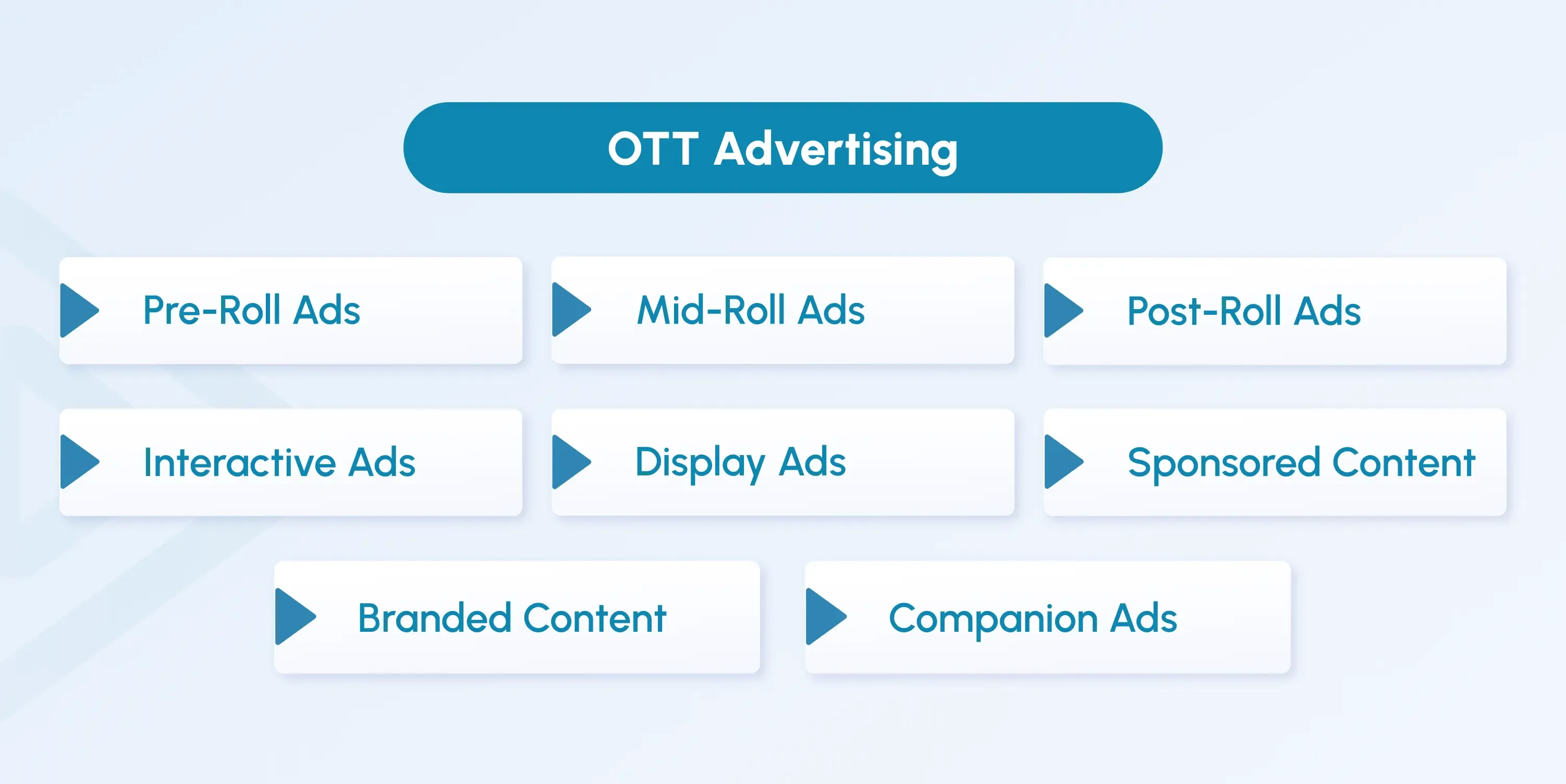 Let’s take a look at some examples of OTT advertising methods below.
Let’s take a look at some examples of OTT advertising methods below.
Pre-Roll Ads: Ads that appear before the content starts fall under this category. They are comparable to traditional TV ads but tailored to OTT streaming platforms.
Mid-Roll Ads: These OTT ads play in the middle of streaming content, interrupting the watching process momentarily. They are generally shorter than traditional TV ad breaks.
Post-Roll Ads: Ads shown when the content has finished or during credits are called post-roll ads. They allow brands to engage viewers who have completed watching their chosen content.
Interactive Ads: Here, ads allow viewers to connect directly with the content by clicking on overlays, choosing various paths within the ad, or purchasing directly from it.
Display Ads: These ads are fixed or animated and appear alongside or on streaming content. The OTT ad examples in this category include banners, overlays, or pop-up windows that don’t interrupt the primary video.
Sponsored Content: Companies can advertise specific content, episodes, or even series on streaming platforms. where their brand or products are integrated into the storyline or featured prominently throughout the content.
Branded Content: Like sponsored content, branded content involves creating custom content for the OTT platform that aligns with the brand's mission and values.
Companion Ads: These ads display while the main content is playing, usually without interrupting the content-watching process. Examples include banners, logos, or other visual elements.
Ultimately, OTT ads allow you to customize your messaging to fit your target audience's viewing patterns, increasing the impact of ads and audience engagement.
What are The Best OTT Advertising Platforms
There are many OTT advertising platforms that you can choose to reach their target audiences effectively.
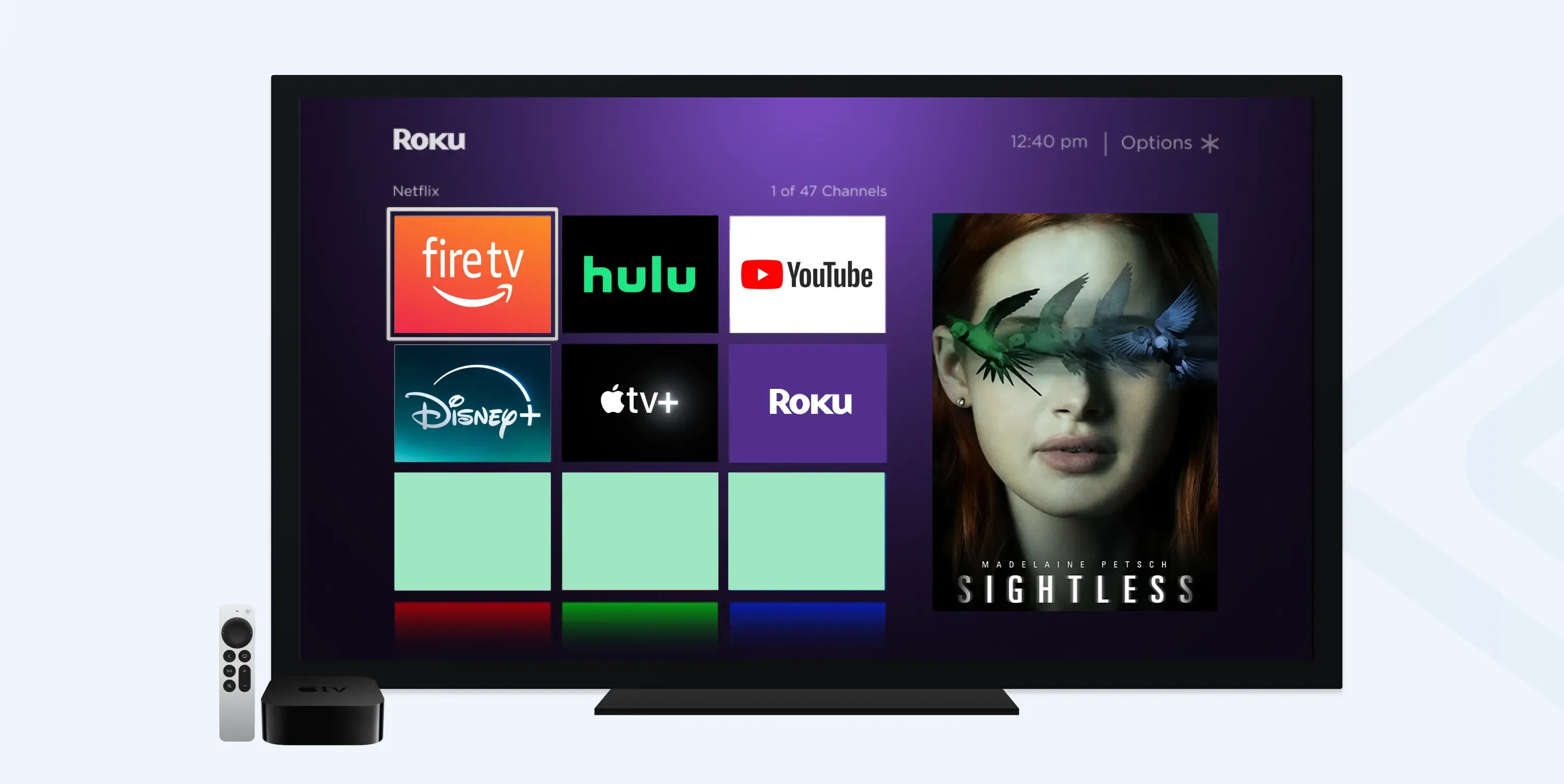 Here are some of the best OTT advertising platforms:
Here are some of the best OTT advertising platforms:
YouTube
As the largest video-sharing platform globally, YouTube offers advertisers robust targeting options and extensive reach through its TrueView (where the number of times a skippable video ad is viewed to completion or 30 seconds) and bumper ad formats.
Google Ads is the central platform for managing YouTube advertising campaigns, providing powerful tools for effective connection with diverse audiences.
Hulu
This OTT TV advertising platform is well-known for its extensive library of TV shows and movies. It allows advertisers to reach engaged viewers with personalized OTT video ad experiences, including interactive and non-skippable ads.
Roku
As an OTT advertising platform, Roku provides access to thousands of channels. It offers targeted advertising opportunities through its Roku Channel and third-party apps.
Amazon Fire TV
With Amazon's Fire TV platform, viewers can access streaming services and apps on many devices. This allows advertisers to reach Amazon's massive audience through various OTT video ad formats.
Disney+
This streaming service has gained significant popularity worldwide. It’s one of the best OTT advertising platforms for brands to reach family-friendly audiences through ad-supported and branded content options.
Apple TV+
This streaming service offers a premium platform for advertisers targeting affluent and tech-savvy audiences through its exclusive content and personalized ad experiences.
The above examples vary in audience demographics, content offerings, and ad formats, providing advertisers with diverse options to tailor an OTT advertising strategy based on the target audience and campaign objectives.
How Do OTT Platforms Measure the Success of Advertising Campaigns?
OTT advertising companies and platforms measure and track the success of ad campaigns through various methods and analytics tools, such as:
1. Ad Impressions: Tracks how often an OTT ad insertion is shown to viewers, which helps you understand your audience size and reach of your campaigns.
2. Viewability: Whether viewers watch an ad and the duration for how long the ad was watched.
3. Ad or Viewer Completion Rates (VCR): The percentage of viewers who didn’t skip the ad and watched until the end is another valuable metric. It indicates the ad’s ability to retain viewers’ attention, although OTT ads can also be in a non-skippable format, automatically boosting this metric.
4. Gross Rating Points (GRP): Measures the impact an advertising campaign has. It shows how many people saw the ad and how often they saw it. You find GRP by multiplying the percentage of your target audience that saw the ad by the number of times they saw it. This helps you understand how broad and frequent your campaign’s reach is.
5. Target Rating Points (TRP): TRPs are like GRPs but focus only on your target audience. They measure how many of your target audience saw the ad and how often. This helps you understand how well your OTT ad is performing with the people you want to reach the most.
6. Click-Through Rates (CTRs): For interactive ads, CTR measures the number of viewers who click on the ad to take further action, such as visiting a website, downloading an app, or purchasing something.
It indicates the level of interest in the ad. OTT platforms may also monitor other engagement activities, such as actions with interactive elements within the ad (e.g., clicks on overlays), video interactions (e.g., rewinds, pauses), or social shares.
7. Conversion Tracking: Measures actions that viewers take after seeing the ad, such as buying, signing up for a newsletter, or visiting a physical store location. This helps advertisers tie ad exposure directly to business outcomes.
8. Audience Demographics: Provides information on the demographic characteristics of viewers exposed to the ad, including age, gender, location, and interests. This data helps advertisers understand their target audience and prepare for future actions and campaigns.
9. Return on Investment (ROI): OTT platforms enable advertisers to analyze ROI, assess their campaigns' overall effectiveness, and make data-driven decisions for future OTT advertising strategies.
Best Practices for OTT Advertising
Here are some of the OTT advertising best practices for well-known OTT platforms.
Take Advantage of Advanced Targeting
Companies can use data-driven insights to target specific demographics or behavioral segments.
Example
Hulu's targeted advertising options allow brands to reach audiences based on demographics, interests, and viewing habits, ensuring relevant and impactful ads.
Use Interactive Elements
Interactive elements like clickable overlays or mini-games also increase engagement.
Example
Netflix's interactive content, such as "Bandersnatch," allows viewers to make decisions that affect the storyline, creating more engagement with branded content.
You can also use QR codes, call-to-action buttons, or gamification for a more immersive ad experience.
Deliver Personalized Ad Experiences
Hyper-personalization based on viewer preferences or viewing history allows you to create different variants of your OTT video ad to cater to specific demographics.
Example
Amazon Prime Video uses viewer data to recommend content and serves ads corresponding to the viewer’s interests, enhancing relevance and effectiveness.
You can implement dynamic ad insertion (DAI) to serve the most relevant ad to each viewer.
An important part of ad personalization is ensuring that OTT ad placements fit naturally within the viewing experience without disrupting the content flow. A great example is YouTube TV, which integrates ads into its platform to mimic the traditional ad experience, making them less intrusive and more acceptable to viewers.
Maintain Consistent Ideas and Branding Across Platforms and Devices
Use consistent branding and messaging across OTT platforms to enhance brand recognition, awareness, and recall.
Example
Disney does an excellent job of this on its OTT platforms (Disney+ and Hulu), reinforcing its brand identity and ensuring a unified viewer experience.
Measure Ad Performance
Set clear and attainable key performance indicators (KPIs) to monitor the success of your OTT advertising strategy. Some noteworthy metrics include view-through rates, engagement, and conversions. Use powerful analytics to optimize your OTT ad insertion campaigns in real time.
Example
Roku offers detailed analytics that help advertisers track viewer engagement and adjust ad strategies accordingly, improving campaign effectiveness.
Be Innovative
Experiment with new ad formats (e.g., 360-degree videos, AR experiences) to stand out and capture viewer attention.
Example
During live sports streaming on OTT platforms, ESPN's AR enhances viewer interaction and provides a memorable advertising experience.
Focus on Ad Frequency and Timing
Control the frequency of your OTT ads using frequency capping to avoid viewer fatigue and negative perceptions.
Example
Spotify allows users to choose their ad experience by offering a premium ad-free subscription, minimizing interruptions while listening to music or podcasts.
You can also optimize ad delivery times to reach targeted viewers when they are most likely to be receptive. The goal is to balance the frequency of an OTT video ad with the right timing for maximum impact.
Align Your OTT Ads With Relevant Content
Deliver ads to your targeted audiences that are related to the content. It’s unlikely that an ad about beauty products will appeal to many viewers watching a nature survival show.
Example
HBO Max inserts OTT ads relevant to the shows' concepts, ensuring that the displayed ads truly resonate with the audience.
Be Data-Compliant
Follow privacy laws and maintain clear policies on how viewer data is used.
Example
Apple TV+ emphasizes user privacy by limiting ad tracking and giving users control over their data, fostering viewer trust.
OTT Advertising Statistics
Still wondering whether OTT ads are an effective form of marketing? Let’s look at some of the latest OTT advertising statistics to clarify.
- OTT ad spending in the United States is projected to reach $14.6 billion by 2024, up from $8.1 billion in 2021. (eMarketer)
- The global OTT market size is predicted to grow from $121.61 billion in 2020 to $1,039.03 billion by 2027 at a compound annual growth rate (CAGR) of 29.4%. (Grand View Research)
- Netflix, Amazon, Hulu, Disney+, and Max are among the top global streaming platforms in 2024. (Forbes)
- 99% of U.S. households have at least one OTT service subscription. (Forbes)
- 62% of OTT viewers prefer ad-supported services with free content over ad-free subscription services. (Forbes)
- OTT users spend an average of 21 hours per week streaming content. (Forbes)
- Pre-roll ads have an average completion rate of 90% on OTT platforms. (Innovid)
- Compared to traditional TV ads, interactive ads on OTT platforms can increase engagement rates by up to 5 times. (Hulu)
- 80% of adults use ad-supported streaming services. (JamLoop)
- 45% of OTT viewers purchase after seeing an ad on an OTT platform. (Statista)
So, OTT advertising can be revolutionary for your business. All you have to do is get to know your target audience and use the analytic metrics to your advantage. Need further guidance? inoRain got your back. Contact us to learn more.
how to buy ott advertising? Monetization Process
Wondering how to buy OTT advertising? What about the expenses, monetization strategies, and potential outcomes? In this section of our OTT advertising guide, we answer these questions in detail.
What Does OTT Advertising Cost?
OTT advertising costs vary according to factors like OTT platforms, target audience, ad format, pricing model, and ad space competition. Generally speaking, OTT ads cost less than traditional TV advertising, with Cost Per Mile (CPM) or cost per thousand impressions ranging from $5 to $30.
For example, YouTube has an average CPM of $20–$25, while connected television (CTV) ads sit in the $35–$65 CPM region. Here’s a breakdown of other types of OTT advertising costs and pricing models:
- Cost Per View (CPV): Charged each time an OTT ad is watched, usually for a specific duration.
- Cost Per Click (CPC): Charged based on the number of clicks on the ad.
- Flat Rate: A set price for a specific ad placement or time period.
- Programmatic Bidding: Costs are determined through automated bidding systems based on audience targeting and competition.
- Ad Placement Fees: OTT ad expenses may include placement fees based on ad format, position, and viewer demographics. Utilizing advanced targeting capabilities and audience data provided by OTT platforms may involve additional costs.
- Ad-Serving Fees: OTT advertising costs may also include ad-serving fees related to serving ads to viewers, ad-serving technology, and platforms.
How to Buy OTT Advertising in 10 Steps
You need to adopt a strategic approach to buy OTT ads and ensure maximum impact and ROI.
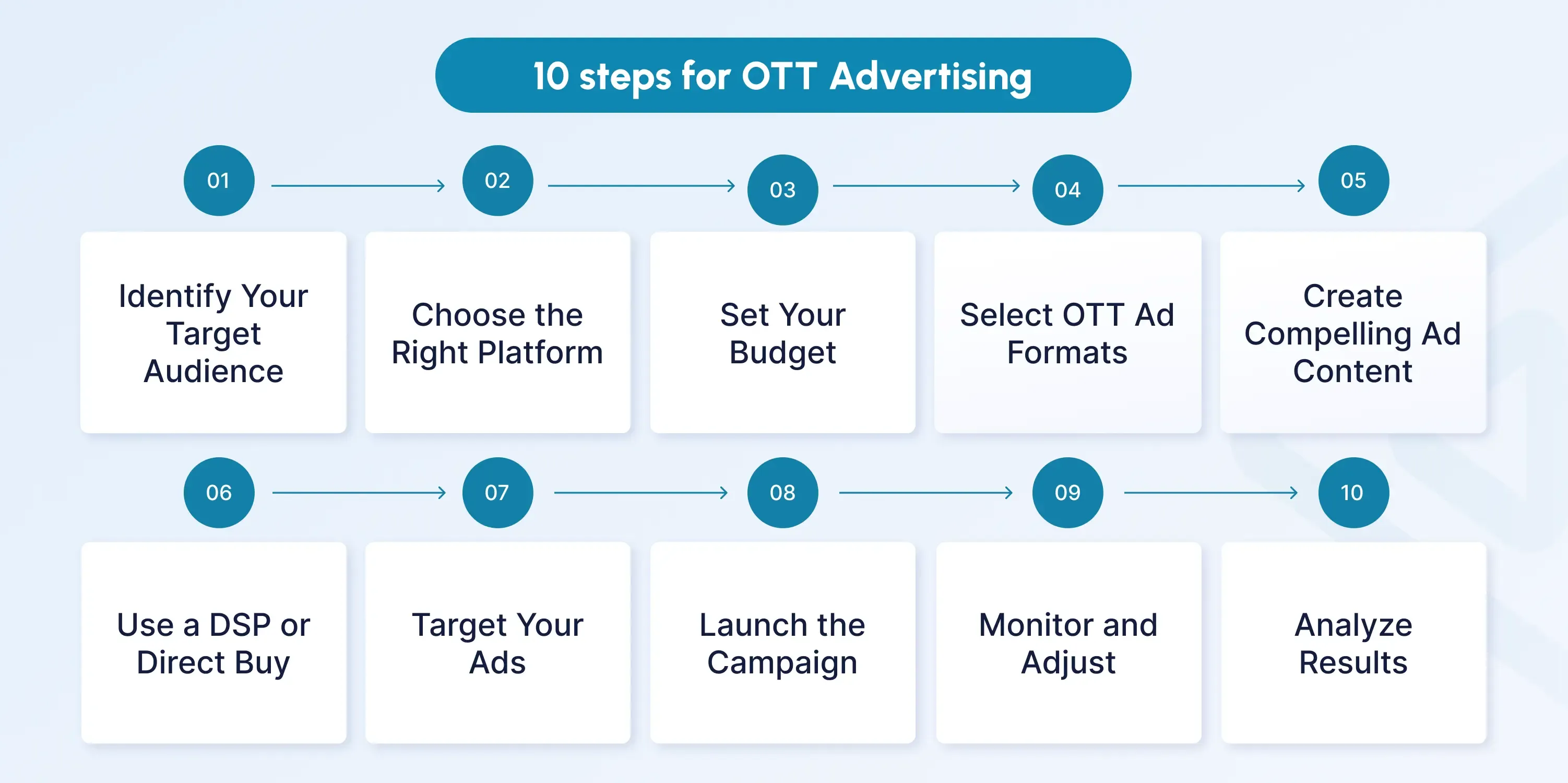 Here is a step-by-step guide detailing the process:
Here is a step-by-step guide detailing the process:
Step 1: Identify Your Target Audience
Determine the demographics, interests, and viewing habits of your desired audience.
Step 2: Choose the Right Platform
Select a popular OTT platform, such as Hulu, Roku, Amazon Prime Video, or others, that best suits and reaches your target audience.
Step 3: Set Your Budget
Decide how much you will spend on the campaign, including CPM, CPV, or other pricing models.
Step 4: Select OTT Ad Formats
Depending on your campaign goals, you can choose from various OTT ad formats, such as pre-roll, mid-roll, post-roll, or display ads.
Step 5: Create Compelling Ad Content
Develop high-quality, engaging OTT ad content tailored to your target audience and platform specifications.
Step 6: Use a DSP or Direct Buy
Utilize a Demand-Side Platform (DSP) for programmatic ad buying or contact the OTT platform directly to purchase ad space.
Step 7: Target Your Ads
Use the platform’s targeting options to reach specific audience segments based on demographics, location, behavior, and interests.
Step 8: Launch the Campaign
Schedule your OTT ads to run at optimal times and on relevant content to maximize exposure and engagement.
Step 9: Monitor and Adjust
Track performance metrics and adjust your campaign as needed to improve results and ROI.
Step 10: Analyze Results
Review the relevant analytics during and after your campaign to understand its effectiveness and gather insights for real-time changes or future efforts.
Monetization: OTT Advertising Revenue Models
There are different types of OTT advertising revenue or monetization models that allow you to generate revenue on an OTT platform:
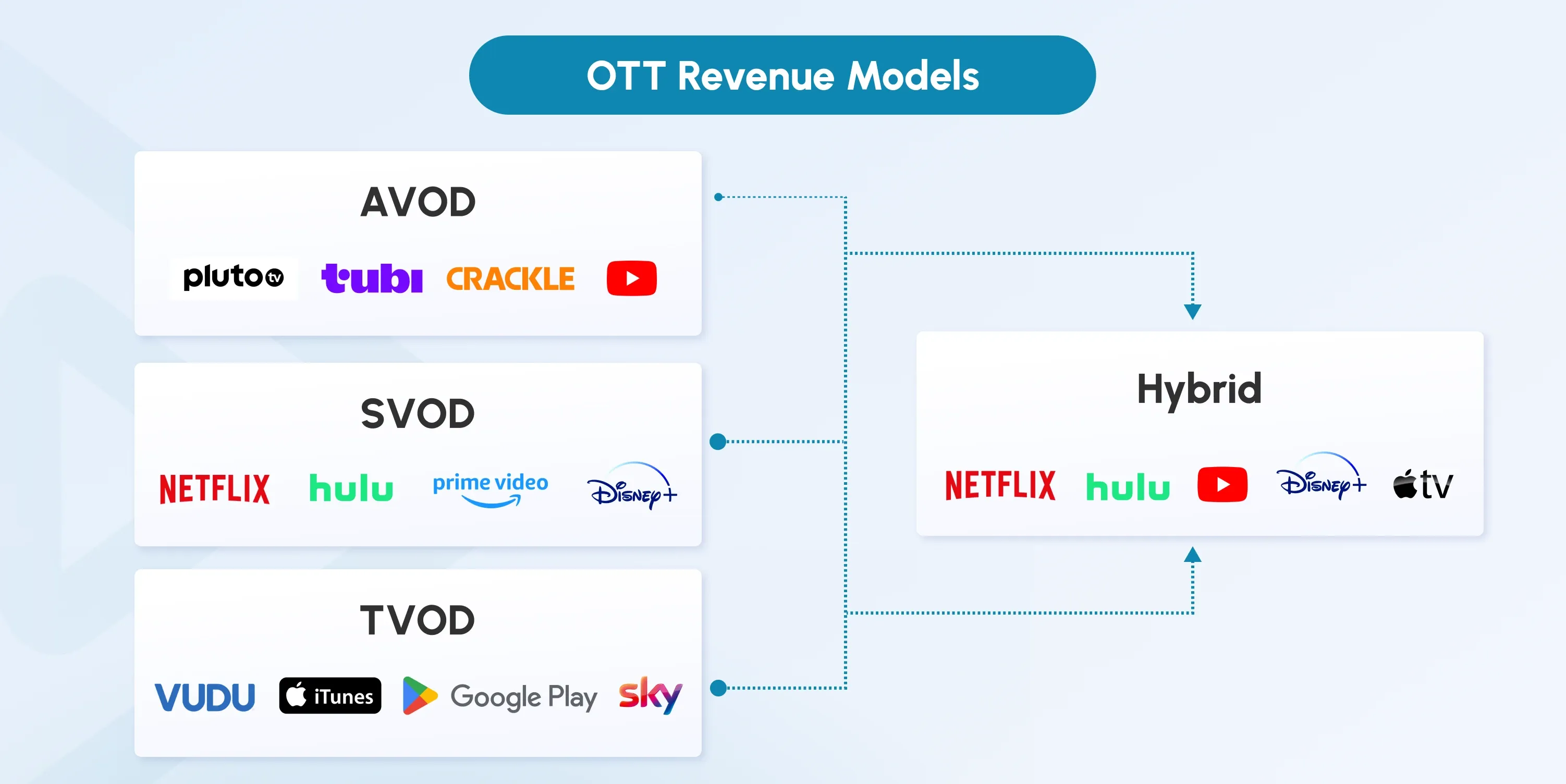
- Ad-Supported (AVOD or advertising-supported video on demand): Users can access the content without a fee, but ads appear during playback.
- Subscription (SVOD or subscription video on demand): Users pay a monthly subscription fee for on-demand access to a premium content library.
- Transactional (TVOD or transactional video on demand): Users can pay a one-time charge to access specific content.
- Hybrid (HVOD or hybrid video on demand): This model combines multiple monetization models (e.g., SVOD +TVOD).
OTT platforms generate revenue by selling ad inventory to advertisers. This income is typically based on the number of impressions, clicks, or other engagement metrics delivered.
OTT platforms may share advertising revenue with content creators or providers based on agreements, where content owners generate revenue from ads displayed alongside their content.
Succeed in Your OTT Advertising Strategies with inoRain
Are you considering OTT advertising services or platforms but unsure where to start or if you’ll succeed? Below are three proven ways inoRain can help you with.
1. Leverage Contextual Targeting
inoRain helps you connect with your specified audience by targeting content that is contextually compatible with your campaign. This way, your ads are much more relevant and engaging, leading to higher viewer retention, better conversion rates, and an increased ROI.
2. Maximize Your Revenue With Flexible Monetization Models
With our 10+ monetization models, you can select the one that best fits your business goals. Whether you prefer AVOD, SVOD with ads, hybrid models, or custom ads, inoRain allows you to adapt your strategy and maximize revenue while catering to your audience’s preferences.
3. Implement a Custom White-Label OTT Solution
Do you want to establish your brand-specific OTT platform to increase brand awareness and revenue? If so, our all-in-one customized white-label OTT solution is for you.
Designed to meet the demands of modern digital audiences, our OTT white-label solution offers comprehensive content management and robust streaming tools. We ensure effective content delivery across multiple platforms and targeted audiences for maximum effectiveness.
Want to know more about how inoRain’s OTT solutions can drive your success? Request a demo or book a free consultation today.
OTT Advertising Trends
No OTT ad guide is complete without looking at some of the latest OTT advertising trends. Let’s see what market shifts are currently taking place.
- SVOD is the most common OTT monetization model. Users need to subscribe to access ad-free content. The challenge of keeping subscriptions has led to new AVOD and free ad-supported TV (FAST) options.
- AVOD and FAST channels have become more popular in recent years. Nowadays, most CTVs come pre-loaded with them. AVOD and FAST give users flexibility in enjoying entertainment, making them the most popular OTT models. FAST streaming delivers live TV viewership without a subscription.
- Today’s digital audience expects a personalized advertising approach. That’s why OTT platforms offer highly targeted ads related to content. Irrelevant ads are a waste of money and effort, so OTT platforms show ads based on viewers' habits, searches, and demographics. Location-based OTT ads allow advertisers to engage the right targeted groups, maximizing the impact of brands’ ads.
- Interactive ad formats are getting more popular. OTT ad types, such as clickable overlays, interactive videos, and personalized ad experiences, are being increasingly adopted. These formats enhance viewer engagement by allowing users to interact directly with the ad content, leading to better brand recall and higher conversion rates.
- OTT advertising campaigns are focused on measurement and analytics. Thanks to the advent of generative AI, many OTT platforms have powerful analytics tools. They typically track viewings, ad clicks, future actions, and buying behaviors. This helps businesses optimize campaigns in real time and track ROI.
Conclusion
OTT, or over-the-top advertising, is a big threat to traditional ads. It’s more affordable, flexible, and targeted, allowing businesses to reach a wider audience. With various content-based OTT ad types, real-time data insights, and flexible monetization models, you can use OTT advertising to drive business growth and stay competitive.
Knowing the market situation and using current trends to your advantage can increase brand recognition among your target audience, which is what you should aim for in the first place. Keep everything on track and constantly innovate your business with new analytics-based decisions.
The more you learn about your target audience, the better, is the last piece of advice from our OTT advertising guide.
The question is, are you ready to start? If yes, contact inoRain today to stay ahead with best-in-class end-to-end OTT solutions!
Frequently Asked Questions
Co-founder / CTO
Armen is the CTO and Co-Founder of inoRain OTT and Co-Founder of HotelSmarters, specializing in advanced streaming technologies, OTT strategy, and interactive TV systems. He builds scalable end-to-end video delivery solutions and drives technical innovation across hospitality and streaming platforms, bridging complex engineering with practical business impact.

How to Develop a Video Streaming App: Best Practices
Learn the basics of developing a modern video streaming app. This guide covers key best practices to help you build the right way from the start.

How to Make a Short Video App (2026 Complete Guide)
Learn how to build a short video app in 2026. Explore micro-drama trends, key features, monetization models, and step-by-step development insights.

Video Streaming Protocols: Types and Use Cases
Learn about video streaming protocols, how they work, key factors to consider, and the challenges involved in choosing the right protocol.
